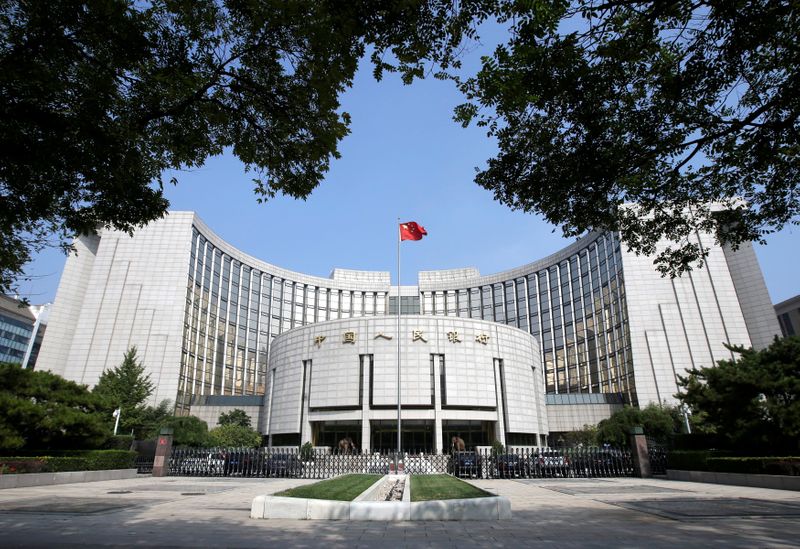LONDON (Reuters) - China has cut the reserve requirement ratio (RRR) for all banks by 50 bps, releasing around 1 trillion yuan ($154 billion) in long-term liquidity to underpin a post-COVID economic recovery that is starting to lose momentum.
Below are analysts' views on the move:
MANIK NARAIN, HEAD OF EM STRATEGY, UBS, LONDON
"It is not clear at all that it is opening the floodgates of liquidity into the system - I think it is, however, China showing the world that there is a limit to how much tightening (in the money markets) it will allow."
"China was first in, first out (with COVID policy support) - it effectively started tightening (monetary policy) in Q3 last year - so now it is possible that the message is, if you are thinking about global significance, that the PBOC is showing that economies are still somewhat fragile and inflation is not likely to be too damaging over the medium term."
ZHIWEI ZHANG, CHIEF ECONOMIST, PINPOINT ASSET MANAGEMENT, HONG KONG
"Some market analysts expect a targeted RRR cut for part of the banking sector, but the PBOC cut across the board for all banks. We continue to expect June macro data to show further slowdown, particularly in consumption. Retail sales already disappointed in April and May."
"Moreover, China’s unbalanced recovery paints a worrying picture for other countries who just started to recover from the pandemic. The new normal of economic growth may be slower than the pre-COVID period, and this may last much longer than expected."
GUSTAVO MEDEIROS, DEPUTY HEAD OF RESEARCH, ASHMORE GROUP, LONDON
"The 50-bps cut in reserve requirement ratio came slightly earlier than most expected. China is likely to ease monetary policy via RRR cuts and OMO operations in order to allow for more local government bond issuance. This will support strategic infrastructure investment such as railways and 5G rollout. We expect fiscal policy to remain focused on specific sectors most affected by the pandemic like small companies. We also expect macro prudential tightening on the property market to remain in place."
RAYMOND YEUNG, CHIEF ECONOMIST GREATER CHINA, ANZ, HONG KONG
"We believe the PBOC’s move today is intended to demonstrate that China has a variety of policy tools to conduct monetary policy. The authorities continue to emphasise that their policy stance is flexible."
"Today's RRR cut is almost equivalent to a broad-based easing, as it will release about 1 trillion Chinese yuan in funds. We see today’s cut as a move to offset the increased need for liquidity seen hitherto in July, which has caused market volatility recently."
JULIAN EVANS-PRITCHARD, SENIOR CHINA ECONOMIST, CAPITAL ECONOMICS
"Our assessment is that the PBOC is trying to nudge banks to lower lending rates without shifting its broader policy settings, such as its quantitative controls on credit. If we are right, then the near-term economic implications of the RRR cut are likely to be small. History suggests that China’s economic performance is much more sensitive to the quantity of credit available rather than its price."
"The bond market appears to be responding to this turn in the cycle by pricing in lower interest rates over the medium term, which is something we’d been expecting. Even prior to the RRR announcement, hints earlier this week that a cut was coming led China’s 10-year government bond yield to post its biggest weekly decline this year."
LOUIS KUIJS, HEAD OF ASIAN ECONOMICS, OXFORD ECONOMICS, HONG KONG
"The PBOC followed up on the State Council’s call 2 days earlier to cut the RRR... By itself, the 50 bps decrease implies a sizeable injection of liquidity."
"However, the PBOC’s language around the cut is telling. It describes it as needed to compensate for the impact of the expiration of tranches of its MLF facility in July and August. This indicates that, as we expected, the central bank wants to see this largely as a liquidity management operation, not a move heralding a shift towards an easier overall monetary policy stance."
ELWIN DE GROOT, HEAD OF MACRO STRATEGY, RABOBANK, AMSTERDAM
"I see it as more or less a fine-tuning rather than a signal that there is more monetary easing coming."
"It was already signalled to some extent because we had seen some tightening in Chinese money markets, and this is basically to alleviate these pressures."
LAURA WANG, CHIEF CHINA EQUITY STRATEGIST, MORGAN STANLEY, HONG KONG

"We think the broad-based 50 bps RRR cut announced by the PBOC should help stabilize investor sentiment, after days of heightened volatility following the July 6 capital market announcement which had caused major concerns over ADRs and offshore Chinese listings."
"We reiterate our strong preference for the A-share market within Chinese equities broadly. We believe the sentiment and liquidity support from the RRR cut would be the biggest for the A-share market. We still do not recommend broad-based bottom-fishing, particularly in the segments still facing regulatory uncertainty (data-heavy tech companies, ADRs, etc.)."